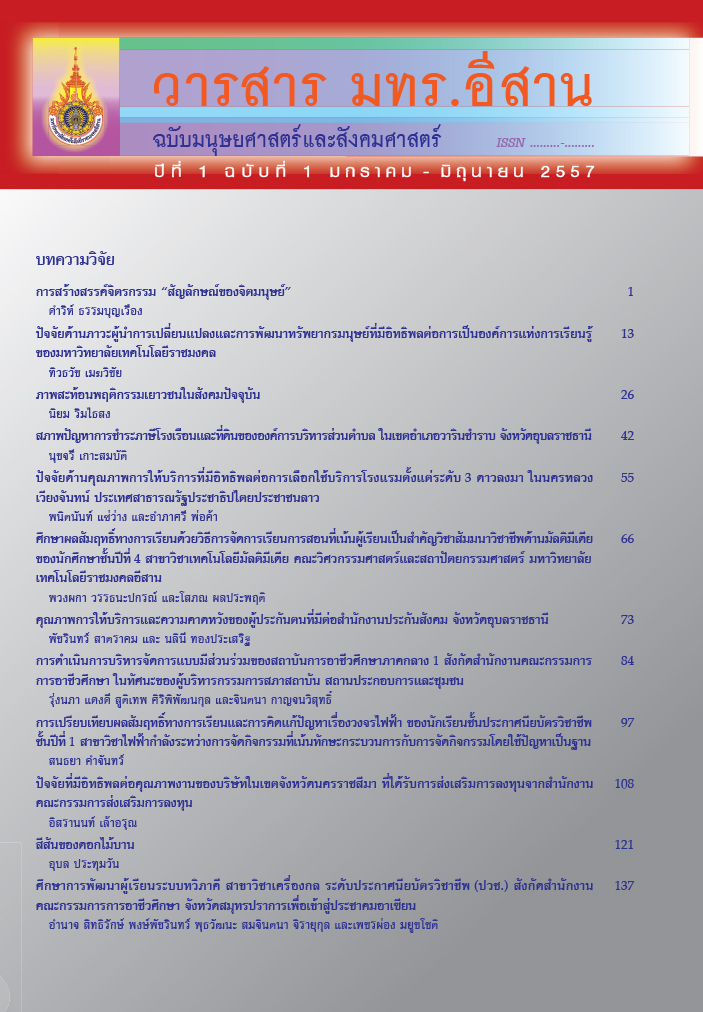Symbols of mind
Main Article Content
Abstract
The Purposes of this research were : 1) to study ten Abstract Expressionism paintings of Franz Marc during 1880 - 1969 in aspects of palette, line, distortion and symbol 2) to create four paintings in acrylic on canvas in subject matter of “Symbols of Mind in Painting”. The sampling were ten Abstract Expressionism painting of Franz Marc during 1880 - 1969 which obtained through purposive sampling random. Tools were four paintings created by the researcher. Data collected from three art experts using Applied Delphi Technique.
The results were as follows :
1. To study Abstract Expressionism of Franz Marc during 1880 - 1969 found that, the palette used by the artist were complementary colors; warm and cool colors in 60 : 40 ratio. The Lines were actual lines, edge lines to created shapes and forms. The distortion of formsaimed to make them attractive and interesting. The animals and forms in environment were distorted to symbolized feeling through nature.
2. The four paintings created by the researcher; the colors used to comumicate human mind, dimension of colors were both cool and wormatmosphere. with various colors. The lines both actual lines and edge lines were created to shown permanent of life of the human mind. The distortion of form such as animal, human and environmental objects made by syplification deformity and bending. to show passions and lust. The eyes were symbols of deterioration society, animals and objects symbolizednature and emotion.
Article Details
บทความที่ได้รับการตีพิมพ์เป็นลิขสิทธิ์ของมหาวิทยาลัยเทคโนโลยีราชมงคลอีสาน
ข้อความที่ปรากฏในบทความแต่ละเรื่องในวารสารวิชาการเล่มนี้เป็นความคิดเห็นส่วนตัวของผู้เขียนแต่ละท่านไม่เกี่ยวข้องกับมหาวิทยาลัยเทคโนโลยีราชมงคลอีสานและคณาจารย์ท่านอื่นๆในมหาวิทยาลัยฯ แต่อย่างใด ความรับผิดชอบองค์ประกอบทั้งหมดของบทความแต่ละเรื่องเป็นของผู้เขียนแต่ละท่าน หากมีความผิดพลาดใดๆ ผู้เขียนแต่ละท่านจะรับผิดชอบบทความของตนเองแต่ผู้เดียว
References
โกสุม สายใจ. (2554). จิตรกรรมพื้นฐาน. กรุงเทพฯ : โครงการผลิตเอกสารตำราคณะศิลปกรรมศาสตร์สถาบันราชภัฏสวนดุสิต
คฐาวุธ ทองไทย. (2548). สภาวะจิตจากความทรงจำ. หลักสูตรศิลปศาสตรมหาบัณฑิต สาขาวิชาจิตรกรรม มหาวิทยาลัยศิลปากร
จีรพันธ์ สมประสงค์. (2547). ทัศนศิลป. กรุงเทพฯ : แม็ค
ฐิติเทพ ฤกษ์นำชัย. (2553). ความเคลื่อนไหวกับชีวิตปัจจุบัน. หลักสูตรศิลปศาสตรมหาบัณฑิต สา-าวิชาจิตรกรรม มหาวิทยาลัยศิลปากร
นิคอเละ ระเด่นอาหมัด. (2543). กฤษฎีจิตรกรรม. กรุงเทพฯ : โอเดียนสโตร์
นอร์แบร์ท โวล์ฟ. (2552). เอกข์เพรสชั่นนิสม. เขียงใหม่ : บริษัทเดอะเกรกไฟน์อาร์ท จำกัด
นอร์แบร์ท โวล์ฟ. (2552). เเอ็บสเเตรกต์ เอกข์เพรสชั่นนิสม. เขียงใหม่ : บริษัทเดอะเกรกไฟน์อาร์ท จำกัด
ประไพ อมรวีระกุล. (2553). ประวัติศาสตร์ศิลป. กรุงเทพฯ : สทรรรมิก
พีระพงษ์ กุลพิศาล. (2554). การบิดเบือนรูปทรงในทัศนศิลป. อัดสำเนา
พีระพงษ์ กุลพิศาล. (2550). ประวัติศาสตร์ศิลป. (วีดิทัศน์). กรุงเทพฯ : โปรแกรมศิลปกรรม
พีรภัทร โพธิสารัตน. มิตชูโอะ คเวสโค เมื่อซากุระผลิบานเป็นดอกบัว. วารสารซีเครีต. ปีที่ 2. ฉบับที่ 46. หน้า 26-32
รัฐภูมิ ผิวพันธมิตร. (2552). การแฝงตัวของตัณหานิยมในพุทธสังคมปัจจุบัน. หลักสูตรศิลปศาสตรมหาบัณฑิต สาขาวิชาจิตรกรรม มหาวิทยาลัยศิลปากร
ราชบัณฑิตยสถาน. (2541). พจนานุกรมศัพท์ศิลปะ อังกฤษ-ไทย. กรุงเทพฯ : คุรุสภาลาดพร้าว
วิรุณ ตั้งเจริญ. (2523). ศิลปะกับความงาม. กรุงเทพฯ : โอเดียนสโตร. ว.วชิรเมรี. (2552). บนรอยทางแห่งรอยธรรมจากพุทธทาสถึง ว.วขิรเมรี. กรุงเทพฯ : สุขภาพใจ
ศรัญญู นกแก้ว. (2553). ติช นัท ฮันท์ จากเมล็ดพลัมสู่เมล็ดพันธุ์แห่งสันติบนแผ่นดินไทย วารสาร ซีเคร็ต. ปีที่ 3. ฉบับที่ 60. หน้า 26-33
สุชาติ เถาทอง. (2539). หลักการทัศนศิลป. กรุงเทพฯ : นำอักษร
สมชาย พรหมสุวรรณ. (2546). การชื่นชมงานศิลปะ. อัดสำเนา
อารี สุทธิพันธุ์. (2535). ศิลปะนิยม. กรุงเทพฯ : ไทยวัฒนาพานิช จำกัด
Joseph Murphy. (2554). พลังจิตใต้สำนึก. เข้าถึงเมื่อ 7 กุมภาพันธ์ 2554 เข้าถึงได้จาก (http:/ /www.novabizz.com)
Kwandao. (2555). จิตวิทยาในชีวิตประจำวัน. เข้าถึงเมื่อ5 ธันวาคม 2555 เข้าถึงได้จาก (htip:/ /www.Oknation.net/ dog/print.php?id-202217)


